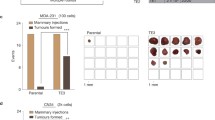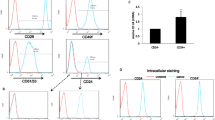Abstract
The process of tumour invasion and subsequent metastasis represents the most lethal aspect of cancer. In this study the invasive and migratory activity of four human breast cancer cell lines; MCF-7, MDA-MB-231, BT474 and Hs578T was investigated. Isogenic subclones were isolated from the Hs578T cell line using sequential passages through the BD Matrigel™ Invasion Chamber assay system. A new invasive subclone designated, Hs578Ts(i)8 was isolated and shown to be 3-fold more invasive and 2.5-fold more migratory than the parental cell line. The variant cells formed up to 25 times more colonies in soft agar and also produced tumours in vivo in nude mice. Flow cytometry analysis showed that the Hs578Ts(i)8 cells had 30% more CD44+/CD24−/low cells than the parental Hs578T cell line. The presence of a breast cancer stem cell population within the variant cell line may provide an explanation for the increased anchorage independent growth and tumourigenicity.







Similar content being viewed by others
References
Boyle P, d’Onofrio A, Maisonneuve P et al (2003) Measuring progress against cancer in Europe: has the 15% decline targeted for 2000 come about. Ann Oncol 14:1312–1325
Ahmad A, Hart IR (1997) Mechanism of metastasis. Crit Rev Oncol/Hemat 26:163–173
Fidler IJ (2003) The pathogenesis of cancer metastasis: the ‘seed and soil’ hypothesis revisited. Nat Rev Cancer 3:1–6
Steeg PS (2006) Tumor metastasis: mechanistic insights and clinical challenges. Nat Med 12:895–904
Lacroix M, Leclercq G (2004) Relevance of breast cancer cell lines as models for breast tumours: an update. Breast Cancer Res Treat 83:249–289
Ross DT, Scherf U, Eisen MB et al (2000) Systematic variation in gene expression patterns in human cancer cell lines. Nat Genet 24:227–235
Bagheri-Yarmand R, Kourbali Y, Rath AM et al (1999) Carboxymethyl benzylamide dextran blocks angiogenesis of MDA-MB-435 breast carcinoma xenografted in fat pad and its lung metastases in nude mice. Cancer Res 59:507–510
Baurle T, Adwan H, Kiessling F et al (2005) Characterisation of a rat model with site-specific bone metastasis induced by MDA-MB-231 breast cancer cells and its application to the effects of an antibody against bone sialoprotein. Int J Cancer 115:177–186
Kim LS, Huang S, Lu W et al (2004) Vascular endothelial growth factor expression promotes the growth of breast cancer brain metastases in nude mice. Clin Exp Metast 21:107–118
Gazdar AF, Kuvari V, Virmani A et al (1998) Characterisation of paired tumor and non-tumor cell lines established from patients with breast cancer. Int J Cancer 78:766–774
Bendre M, Gaddy-Kurten D, Mon-Foote T et al (2002) Expression of interleukin 8 and not parathyroid hormone-related protein by human breast cancer cells correlates with bone metastasis in vivo. Cancer Res 62:5571–5579
Lev DC, Kiriakova G, Price JE (2003) Selection of more aggressive variants of the GI101A human breast cancer cell line: a model for analysing the metastatic phenotype of breast cancer. Clin Exp Met 20:515–523
Williams N, Gyorfi T, Iliopoulos D et al (1992) Growth factor independence and invasive properties of colorectal carcinoma cells. Int J Cancer 50:274–280
Naundorf H, Becker M, Lykkesfeldt A et al (2000) Development and characterization of a tamoxifen–resistant breast carcinoma engraft. Brit J Cancer 82:1844–1850
Weigelt B, Peterse JL, van’t Veer L (2005) Breast cancer metastasis: markers and models. Nat Rev 5:591–602
Al-Hajj M, Wicha MS, Benito-Hernandez A, Morrison SJ, Clarke MF (2003) Prospective identification of tumorigenic breast cancer cells. Proc Natl Acad Sci 100:3983–3988
Ponti D, Costa A, Zaffaroni N, Pratesi G, Petrangolini G, Coradini D, Pilotti S, Pierotti MA, Daidone MG (2005) Isolation and in vitro propagation of tumorigenic breast cancer cells with stem/progenitor cell properties. Cancer Res 65:5506–5510
Sheridan C, Kishimoto H, Fuchs RK et al (2006) CD44+/CD24− breast cancer cells exhibit enhanced invasive properties: an early step necessary for metastasis. Breast Cancer Res 8:R59
Fiebig HH, Maier A, Burger AM (2004) Clonogenic assay with established human tumour xenografts: correlation of in vitro to in vivo activity as a basis for anticancer drug discovery. Eur J Cancer 40:802–820
Workman P, Twentyman P, Balkwill F et al (1998) United kingdom coordinating committee on cancer research (UKCCCR) guidelines for the welfare of animals in experimental neoplasia, 2nd edn. Br J Cancer 77:1–10
Goodell MA Brose K, Paradis G et al (1996) Isolation and functional properties of maurine hematopoietic stem cells that are replicating in vivo. J Exp Med 183:1797–1806
Hirschmann-Jax C, Foster AE, Wulf FF et al (2004) A distinct “side population” of cells with high drug efflux capacity in human tumor cells. Proc Natl Acad Sci 101:14228–14233
Patrawala L, Callhoun T, Schneider-Broussard R, Zhou J, Claypool K, Tang DG (2005) Side population is enriched in tumorigenic, stem-like cancer cells, whereas ABCG2+ and ABCG2- cancer cells are similarly tumorigenic. Cancer Res 65:6207–6219
Hackett AJ, Smith HS, Springer EL et al (1977) Two syngeneic cell lines from human breast tissue: the aneuploid mammary epithelial (Hs578T) and the diploid myoepithelial (Hs578TBst) cell lines. J Natl Cancer Inst 58:1795–1806
Bernards R, Weinberg RA (2002) A progression puzzle. Nat 418:823
Fidler IJ, Kripke ML (1977) Metastasis results from pre-existing variant cells within a malignant tumour. Science 197:893–895
Wang W, Goswami S, Sahai E et al (2005) Tumor cells caught in the act of invading: their strategy for enhanced cell motility. Trends Cell Biol 15:138–145
Brooks S, Locke E, Soule H (1973) Estrogen receptor in a human cell line (MCF-7) from breast carcinoma. J Biol Chem 248:6251–6253
Lasfargues E, Coutinho W, Redfield E (1978) Isolation of two human tumor epithelial cell lines from solid breast carcinomas. J Natl Cancer Inst 61:967–978
Cailleau R, Young R, Olive M, Reeves WJ Jr (1974) Breast tumor cell lines from pleural effusions. J Natl Cancer Inst 53:661–674
Jacob K, Bosserhoff AK, Wach F et al (1995) Characterisation of selected strongly and weakly invasive sublines of a primary human melanoma cell line and isolation of subtractive cDNA clones. Int J Cancer 60:668–675
Kath R, Jambrosic JA, Holland L et al (1991) Development of invasive and growth factor independent cell variants from primary human melanomas. Cancer Res 51:2205–2211
Prest S, Rees RC, Murdoch C et al (1999) Chemokines induce the cellular migration of MCF-7 human breast carcinoma cells: subpopulations of tumour cells display positive and negative chemotaxis and differential in vivo growth potentials. Clin Exp Metast 17:389–396
Guo Y, Pakneshan P, Gladu J et al (2002) Regulation of DNA methylation in Human breast cancer, effect on the urokinase-type plasminogen activator gene production and tumor invasion. J Biol Chem 277:41571–41579
Coopman P, Do M, Barth M et al (2000) The Syk tyrosine kinase suppresses malignant growth of human breast cancer cells. Nature 406:742–747
Hughes L, O’Brien S, Gallagher WM et al (2007) DNA microarray-based transcriptomic profiling of an isogenic cell culture model of breast tumour cell invasion. Anticancer Res 27:1353–1360
Rogulski K, Li Y, Rothermund K et al (2005) Onzin, a c-Myc-repressed target, promotes survival and transformation by modulating the Akt-Mdm-p53 pathway. Oncogene 24:7524–7541
Egeblad M, Werb Z (2002) New functions for the matrix metalloproteinases in cancer progression. Nat Rev Cancer 2:161–174
Bourguignon LY, Gunja-Smith A, Iida N et al (1998) CD44v(3, 8–10) is involved in cytoskeleton-mediated tumour cell migration and matrix metalloproteinase (MMP-9) association in metastatic breast cancer cells. J Cell Physiol 176:206–215
Kaufmann M, Heider HK, Sinn HP et al (1995) CD44 variant exon epitopes in primary breast cancer and length of survival. Lancet 345:615–619
Acknowledgements
The authors acknowledge funding from the Irish Research Council for Science Engineering and Technology (IRCSET) under the National Development Plan and Enterprise Ireland International Collaboration Award.
Author information
Authors and Affiliations
Corresponding author
Rights and permissions
About this article
Cite this article
Hughes, L., Malone, C., Chumsri, S. et al. Characterisation of breast cancer cell lines and establishment of a novel isogenic subclone to study migration, invasion and tumourigenicity. Clin Exp Metastasis 25, 549–557 (2008). https://doi.org/10.1007/s10585-008-9169-z
Received:
Accepted:
Published:
Issue Date:
DOI: https://doi.org/10.1007/s10585-008-9169-z




